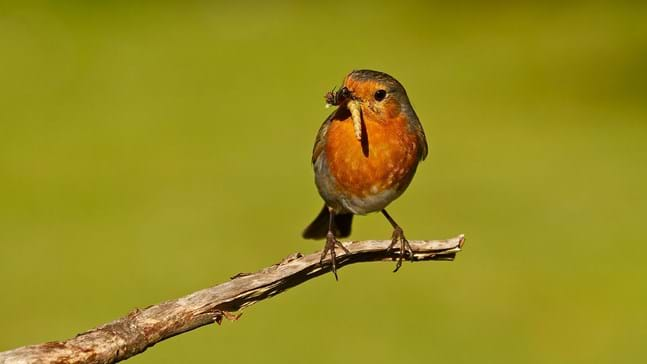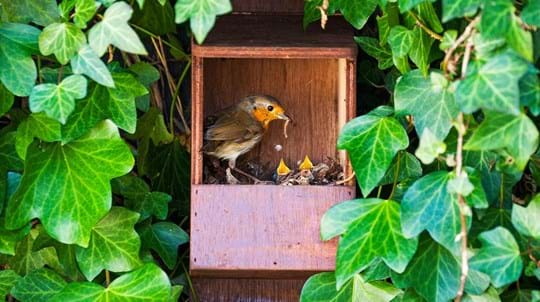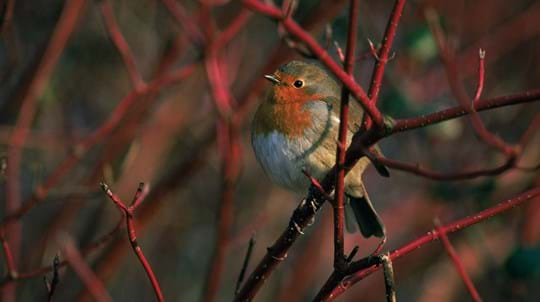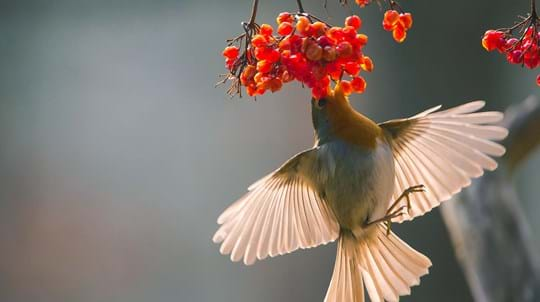
Credit: Tony Cox / WTML
What do robins eat?
Robins enjoy eating fruits, seeds and insects, such as beetles. They also love feasting on earthworms, and can often be seen in gardens on the lookout for juicy worms as they are dug up by gardeners.
Feisty. Iconic. A Christmas-card favourite and a gardener’s best friend. It’s no wonder this fiery little fella is one of Britain’s most-loved birds, frequenting the UK’s gardens in search of worms.
Common name: robin
Scientific name: Erithacus rubecula
Family: Muscicapidae (Old World flycatchers)
Habitat: gardens, woodland, parks, hedgerows
Diet: worms, fruit, seeds, insects
Predators: birds of prey, domestic cats and dogs
Origin: native
With its signature bright-red breast, the robin is immediately recognisable. It has a brown back and white belly, with the orange-red breast stretching up to its throat and face.
Juvenile robins are brown all over with mottled golden flecks.

Credit: Tony Cox / WTML
Robins enjoy eating fruits, seeds and insects, such as beetles. They also love feasting on earthworms, and can often be seen in gardens on the lookout for juicy worms as they are dug up by gardeners.
Robins have been known to nest in some weird and wonderful places, from post boxes to unused barbeques!
The breeding season usually begins in March, although if the winter has been mild it can begin as early as January. The female robin builds a cup-shaped nest using moss, hair, grass and dead leaves, somewhere on or close to the ground. Robins begin laying their eggs between mid-April and mid-August, and a clutch is made up of around 4–6 eggs. Chicks hatch after around 13 days. The chicks fledge approximately two weeks later.

Credit: Ernie Janes / Alamy Stock Photo
Robins are found across the UK in woodland, gardens, parks and hedgerows. They are fiercely territorial, singing to defend their territory all year round. Their red breast is actually used as a territory defender.
Robins are so territorial they have even been seen attacking stuffed robins – the red breast triggering territorial behaviour!
It’s not hard to spot this fiery little bird – chances are you won’t have to go far to see one. Simply step out into your garden and you might spot a friendly robin; these birds are usually very tame. Or, enjoy a walk around your local wood and you could see one perched on a branch, perhaps even singing their silvery song.
Audio: Andrew Harrop / xeno-canto.org

Credit: Nigel Wedge / WTML
Robins are widespread and their population is thought to be stable. They are threatened by harsh winters, however, losing up to 10% of their body weight during just one freezing winter night. You can help robins build up their fat reserves during the winter by putting bird food, such as mealworms, on your garden bird table – they are a favourite for robins.
The reason robins are used so frequently on Christmas cards is because during the Victoria era, when the tradition of sending Christmas cards began, postmen wore red jackets, earning them the nickname ‘robins’.

Blog
Hannah Vickers • 08 Feb 2019

Blog
Charlotte Varela • 10 May 2019

Blog
James Martin • 27 Jan 2020

Blog
Rachel Hoskins • 01 Dec 2019
Blog
Kayleigh Jacobs-Rutter • 13 Feb 2024

Blog
Helen Keating • 05 May 2020

Blog
Amy Lewis • 16 Feb 2022